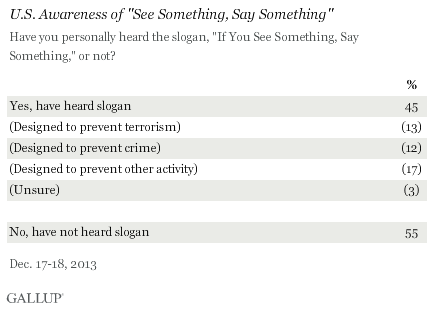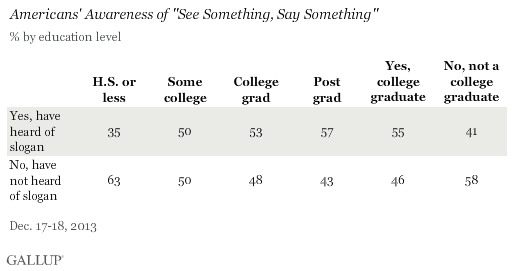WASHINGTON, D.C. -- Less than half of Americans say they have heard of the "If You See Something, Say Something" slogan, part of a government campaign designed to raise public awareness of signs of terrorism and terrorism-related crime. An even smaller percentage correctly identify it as targeting terrorism and crime.

The U.S. Department of Homeland Security (DHS) licensed the use of the slogan in 2010. DHS has awarded millions of dollars in federal grants through its collaborations with dozens of states, cities, sports teams, and other organizations to spread the campaign across the U.S. Yet, a Dec. 17-18 Gallup poll finds that a majority of Americans (55%) have never heard of it.
Residents in Eastern States Much More Likely to Recognize Campaign
Despite DHS' national rollout of this slogan with its partners, large differences in awareness exist across regions, specifically between the East (64%) and the West (37%).

Higher awareness levels in the East may be a reflection of where many of the recent terrorist actions and attempts have occurred. At the same time, lower levels in the South are somewhat surprising, as DHS reports having the most state partnerships in the South. With the South containing transportation hubs such as Atlanta and Charlotte, and the West having major population centers in California, there are substantial awareness gaps for millions of people in the South, West, and Midwest.
Significant Differences Exist by Education
DHS has worked with many organizations -- including national sports leagues, transit systems, and big-box retailers -- to reach people at various education levels, but differences in campaign awareness still exist. Those without college degrees are significantly less likely to be aware of the campaign (41%) than those with college degrees (55%). Differences are widest between those with a high school degree or less (35%) and those with postgraduate degrees (57%).

Bottom Line
Terrorism can occur anywhere and anytime, and any person could see the signs before disaster strikes. For example, two street vendors reported the 2010 Times Square bomb scare to the New York Police Department. To prevent future attacks, high levels of situational awareness and clear action plans could greatly benefit everyone.
Recall is a key metric for branding and marketing efforts, and it is a simple performance evaluation for campaign efforts. DHS has released certain performance metrics from this campaign in terms of inputs (e.g., number of partnerships, grant dollars, YouTube hits) and outputs (e.g., arrests, reports), but some have questioned the quality of these outputs. However, awareness levels from this Gallup poll suggest that a significant portion of DHS' market (namely, the entire U.S.) is unaware of the "See Something, Say Something" campaign. Greater awareness could contribute to the larger outcome metric -- safety.
The relatively low awareness of this campaign slogan suggests there is still significant room for improvement to make the phrase and its aim more universally known. DHS might consider targeting different strategic partnerships in the South and West, researching and developing messaging that connects with those with lower levels of educational attainment, or even reassessing the slogan altogether if the implementation strategy cannot be improved.
Survey Methods
Results for this Gallup poll are based on telephone interviews conducted Dec. 17-18, 2013, on the Gallup Daily tracking survey, with a random sample of 1,019 adults, aged 18 and older, living in all 50 U.S. states and the District of Columbia.
For results based on the total sample of national adults, the margin of sampling error is ±4 percentage points at the 95% confidence level.
Interviews are conducted with respondents on landline telephones and cellular phones, with interviews conducted in Spanish for respondents who are primarily Spanish-speaking. Each sample of national adults includes a minimum quota of 50% cellphone respondents and 50% landline respondents, with additional minimum quotas by region. Landline and cellphone numbers are selected using random-digit-dial methods. Landline respondents are chosen at random within each household on the basis of which member had the most recent birthday.
Samples are weighted to correct for unequal selection probability, nonresponse, and double coverage of landline and cell users in the two sampling frames. They are also weighted to match the national demographics of gender, age, race, Hispanic ethnicity, education, region, population density, and phone status (cellphone only/landline only/both, and cellphone mostly). Demographic weighting targets are based on the March 2012 Current Population Survey figures for the aged 18 and older U.S. population. Phone status targets are based on the July-December 2011 National Health Interview Survey. Population density targets are based on the 2010 census. All reported margins of sampling error include the computed design effects for weighting.
In addition to sampling error, question wording and practical difficulties in conducting surveys can introduce error or bias into the findings of public opinion polls.
View methodology, full question results, and trend data.
For more details on Gallup's polling methodology, visit www.gallup.com.
